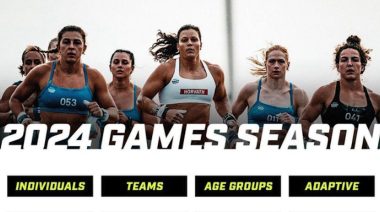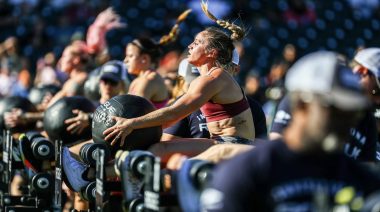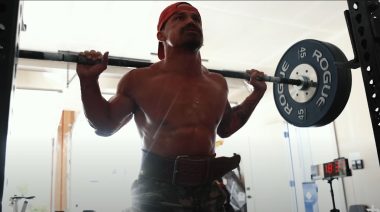Every minute on the minute (EMOM) and you go, I go (YGIG) training sessions reinforce the quality of movements. In this article, I discuss workouts that reinforce low-quality movements and how we can improve by focusing on virtuosity.
CrossFit is an outstanding training system for many people. Those who would disagree with that statement commonly complain that CrossFit can lead to poor quality of movement. In an earlier article, I indicated that this is not CrossFit’s fault. Rather, poor reinforcement systems lead to poor movements. Let’s revisit these principles before examining how EMOMs and YGIG sessions can help.
CrossFit and the Reinforcement System
Many CrossFit workouts have the fastest time or the highest number of reps as the desired outcome. Athletes completing AMRAPs count the number of reps or rounds completed in a particular amount of time. Other workouts use time to complete a specified set of movements as the outcome. The standards reinforced are faster times or more reps, rather than how well you do the movements.
The problem is, although quality movements can lead to better times, sometimes sloppy technique is quicker than proper movement. Dave Castro notes that when doing Olympic snatches for time:
“These lifts can be successful even with inefficient technique, including keeping the hips high, pulling with the arms, not coming to full extension on the second pull, and even swinging the barbell out.”
When you set yourself against time, you focus on getting work done as quickly as possible. The standard you set is what you live up to. It’s self-fulfilling.
This problem did not begin with CrossFit. I’m sure many of you have seen someone load up tons of weight on a squat rack, only to squat down an inch. The incentive for this person is how much weight he “squatted.” Quantifying our workouts in this way prioritizes getting as much done as possible, not how well we move.
So let’s look at ways you can still get the work done, yet focus on quality of movement standards, for the sake of your long-term health and durability.
Using Time as a Guide for Work-Rest Cycles
In a well-designed EMOM, you complete a set amount of work in a minute and then you can rest. I am not talking about the supposed “EMOM workouts” where it takes about 59 seconds to complete the desired movements. Rather, I am talking about EMOMs where the work-to-rest ratio is about even (for example, 30 seconds of work and 30 seconds of rest).
A nice example of this type of training is Pavel Tsatsouline’s ‘Simple and Sinister’:
- Minute 1-3: 20 swings (10 per arm)
- Minute 6: Rest
- Minute 7-16: Get ups (one per side per minute)
Pavel describes taking more rest if you cannot hold a conversation (talk test) before the next set begins. The goal is to have quality reps in each round.
Al Ciampa came up with a variation of this program where you swing only ten times per minute. This allows you to focus on well-formed, powerful movements. With only ten swings per minute, you want every rep to be as powerful as possible. Put this effort and intensity into each rep, and there will be no question as to whether the amount of work you are doing is “enough.”
The purpose of EMOM work is to reinforce quality movement by allowing some recovery between sets.
Share the Work, Increase the Benefit
You go, I go (YGIG) training sessions incorporate many of the same great features of EMOMs. With a training partner of similar abilities, you will have a work to rest ratio of 1:1. YGIG sessions also build in a great sense of camaraderie. When you are resting, you can cheer your partner on. If you do not have a training partner on any given day, you can imagine an imaginary partner’s cadence and reps, and rest for the same time you worked.
Ladders work particularly well with this format. Here is a simple YGIG with swings (substitute with any movement):
- 1 swing you
- 1 swing me
- 2 swings you
- 2 swings me (and so on up to 10)
- 9 swings you
- 9 swings me
- 8 swings you
- 8 swings me (and so on down to 1)
Repeated YGIG ladders are perfect for building strict pull-up strength. The first time I trained to do 25 strict pull ups, I used ascending ladders of YGIG. By changing the top point of your ladder, you adjust the total volume. For example, a ladder to 5 gives you 15 reps. A ladder to 6 gives you 21 reps. You can then perform multiple sets.
- 1 pull up you
- 1 pull up me
- 2 pull ups you
- 2 pull ups me (up to 5, then repeat 3 times, no descending ladders)
Don’t Work Out. Train.
My mentors use terms such as “training” or “practice” instead of “work out.” A training or practice session should leave you feeling refreshed and able to go again the next day, rather than sore and unable to move, like a workout might.
Integrating more EMOM and YGIG training sessions into your program can shift the reinforcement from speed to virtuosity. For long-term durability, quality of movement is more important than how much you lifted or how fast you did something. No one will care how well you did on today’s workout three years from now, but you will remember if you injure yourself due to poor movement.
More on the Benefits of EMOMs:
- EMOMs: The Most Misunderstood Method in CrossFit
- 3 CrossFit Training Formats That Work for Everyone
- Beatdown Avoidance and the Value of Rest in CrossFit
- New on Breaking Muscle Today
Photo courtesy of CrossFit Stars.






